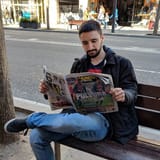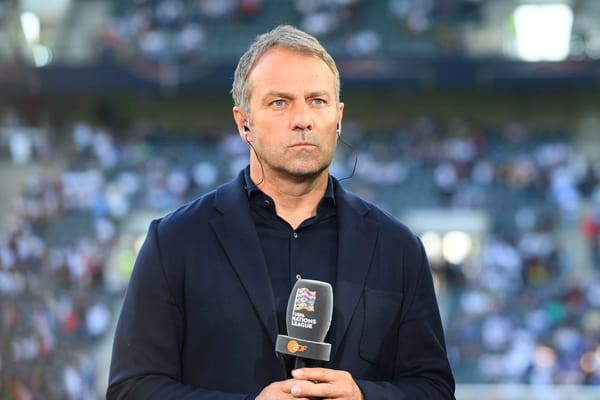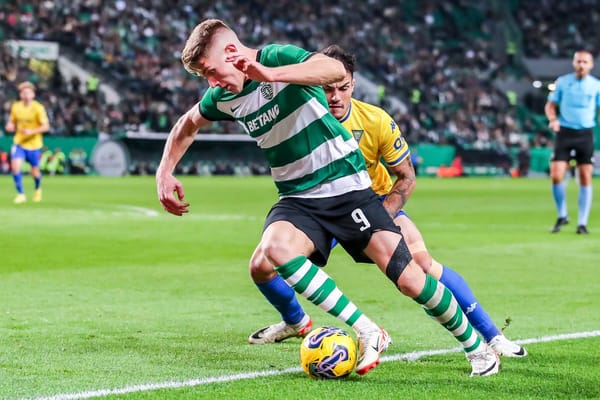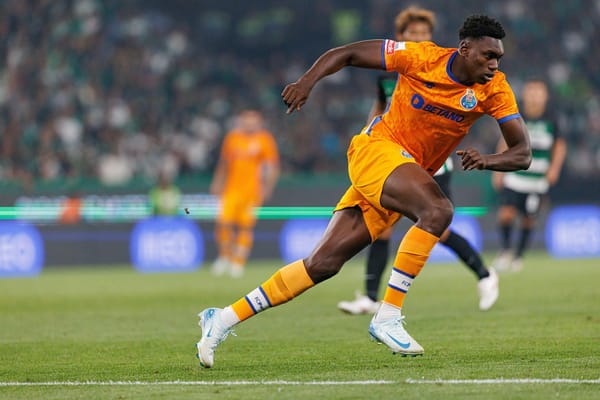The Modern Pivot: 5 players who could replace Sergio Busquets at Barcelona
Replacing Busquets like-for-like will be an almost impossible job. Adjusting his role would probably be the way forward
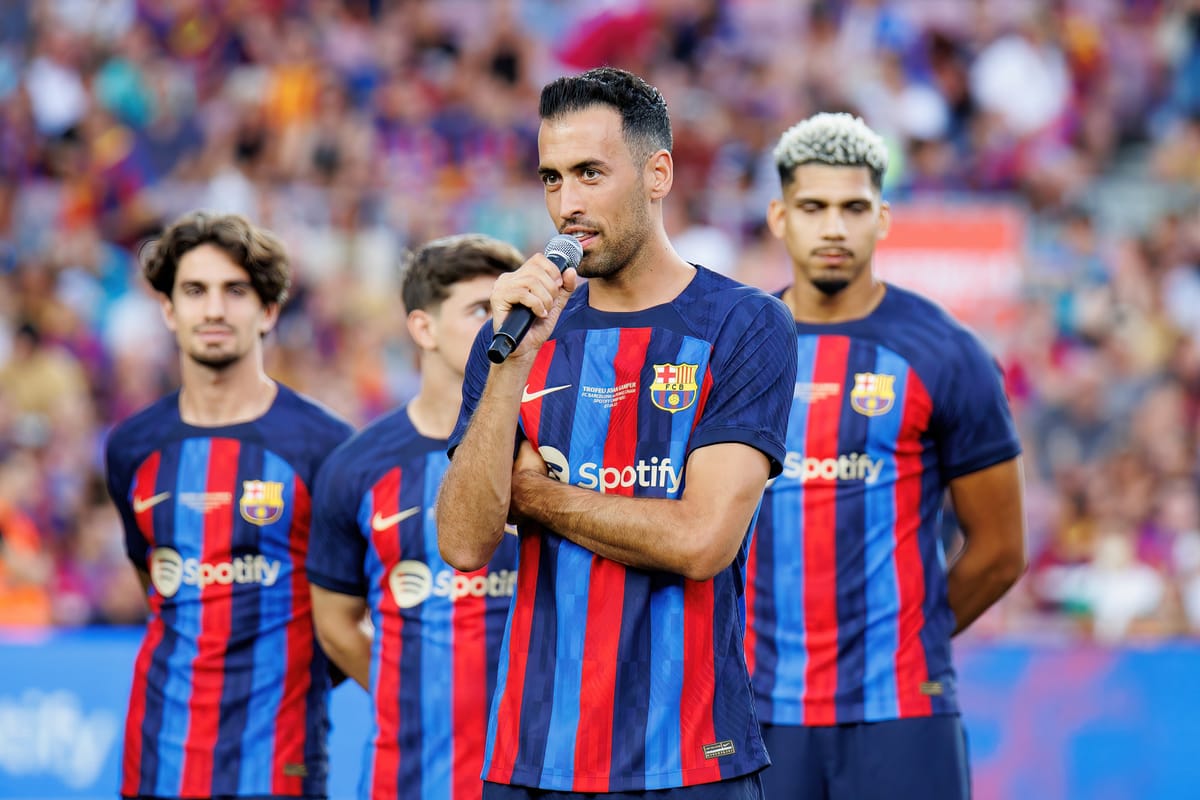
With nearly 2600 minutes to his name in 2021/22, Sergio Busquets is Xavi’s most used player of the season, closely followed only by Marc-André ter Stegen, the team’s undisputed starter between the sticks. But Busquets is also 33 and has been around since Pep Guardiola’s tenure in the Catalan capital. Since then, managers have come and gone, players were sold and bought again, staff members let go and reappointed and crises started and averted. But Busquets has been one of the only solid constants throughout this story.
Ever since his debut, he’s been almost untouchable in the role that is now synonymous with his profile, for better or worse. As years went by, Barcelona haven’t been able to properly replace him. Not for the lack of trying though. But despite some names being whispered in the academy, none are ready to step up just yet and new acquisitions like Frenkie de Jong are still showing glimpses of their brilliance but their profiles don’t perfectly fit the Busquets mould Barcelona is after. This, as we’ve already discussed in a prior analysis, isn’t necessarily a bad thing but also isn’t something the club, or Xavi for that matter, are seriously considering. At least not for now.
This brings us to the very core of this piece. If there’s no one in LaMasia currently capable of relieving Busquets and the first-team squad also lacks such a profile, who can replace him then? The market is a vast but also a very expensive place. And Barcelona are, sadly, a child with no money looking at the most expensive toys through the shop window.
However, while money is scarce, it is not gone entirely. By the summer, with ambitious (or delusions?) of grandeur, Joan Laporta plans to go big. Erling Braut Haaland big. And you don’t go for Haaland if you don’t have money. Judging by their plans, we can conclude Barcelona have, after all, saved up some money in the piggy bank. Or perhaps they’re planning to get it between now and the summer transfer window. But maybe, instead of spending it all on one massive signing, they decide to spread it across multiple positions, one of which could indeed be the defensive midfielder.
Let’s face it, however, the likes of Haaland will always be the priority. But Busquets needs a replacement. If Barcelona refuse to tinker with the system and instead insist on a single pivot structure, they will at the very least have to find someone for Busquets to rotate with.
With that in mind, I brought it upon myself to explore the options the market has to offer. Within reason, of course. But first, let’s do some data analysis.
Trial by numbers
In this section of the analysis, I will guide you through the data that ultimately yielded a five-man shortlist you can find at the end of this piece. When looking for a player who can replace Busquets, it’s logical to look for profiles that match his. However, I’ve gone down a slightly different route too.
Yes, the player(s) we’ll be looking for will have all the trademarks of a traditional Barcelona pivot - elite ball progression, reading of the game, vision, press-resistance and connecting the thirds - but will also be a blend of athleticism and technical quality. In my mind, finding such a player is essential if Barcelona want to retain their tactics of old.
Teams and strategies have evolved massively since the days of their golden generation under Guardiola. Teams are far more aggressive and direct off the ball but they are also stronger, faster, bigger and even more technical on it. That means pressing or just limiting space effectively is more difficult than ever. For that reason, Barcelona, just like their no.6, have to evolve. Enter the modern pivot.
For all intents and purposes, good pressing is a coordinated and most importantly, collective movement, but as good as Busquets is, there are some things his lack of athleticism prevents him from doing. The same can be said for both his offensive and defensive exhibitions. Yes, he was never fast and strong but times have also changed. Busquets can still be effective but it requires the system to be perfectly tailored to his profile too.
The potential new recruit(s) I’ll be looking at here will therefore have to be technically elite but also with an athletic profile that complements it. I’ve used all midfielders from the top five leagues who have played over 600 minutes and have set the age cap at 27. They have been tested on involvement, progression, defensive traits, physicality, press-resistance, duelling and passing to the danger areas. I’ll explain the metrics as we go because I’ve ‘invented’ many of them through different formulas. This should give us players well in their prime who are elite in categories that matter most for the type of player we’re looking for.
Our initial sample boasts 362 midfielders across all five leagues but they will quickly and mercilessly get filtered out in three steps of the data analysis. Just for reference sake, I’ve highlighted De Jong, Nico and Gavi so we see their performance compared to the rest of the players. The first graph we see below deals with involvement and progressive actions.
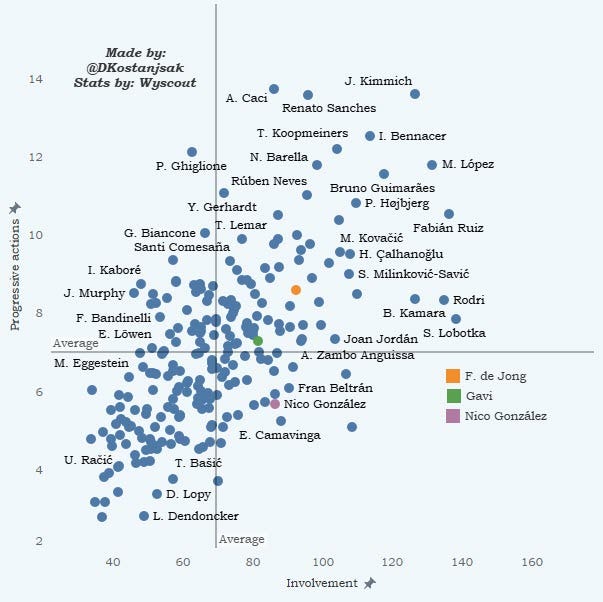
Both metrics are fairly simple to understand. Involvement is a combination of received passes per 90 and total passes per 90, which aims to give us players who are comfortable being the hub of the team, letting the play flow through them. Naturally, Barcelona need a midfielder who can handle constantly dictating games and orchestrating attacks from the deep. Similarly, he has to be elite in connecting the thirds, especially progressing the play in the first phase of build-up, hence the progressive actions per 90 metric. That metric is also easy - we got it by combining progressive passes per 90 and progressive runs per 90.
At this point in our analysis, there are a lot of names present but only the best will be considered. In order to only get the best, though, we have to look at the upper-right quadrant where you can see players with an above-average tally for both involvement and progressive actions. So players like Joshua Kimmich, Renato Sanches, Mateo Kovačić and the like. Interestingly, we see that both Gavi and De Jong do well in these two metrics and will, in fact, be advancing to the next round.
Before we go to the next graph, remember, only the ‘elite’ from the first graph will make it onto the second one. To be slightly less rigorous, I’ve decided to include players who are only marginally below average in one of the metrics, which also lowers the risk of potentially leaving out someone who could still end up being very good. That being said, the next graph will deal with press-resistance and passes to the danger area per 90.
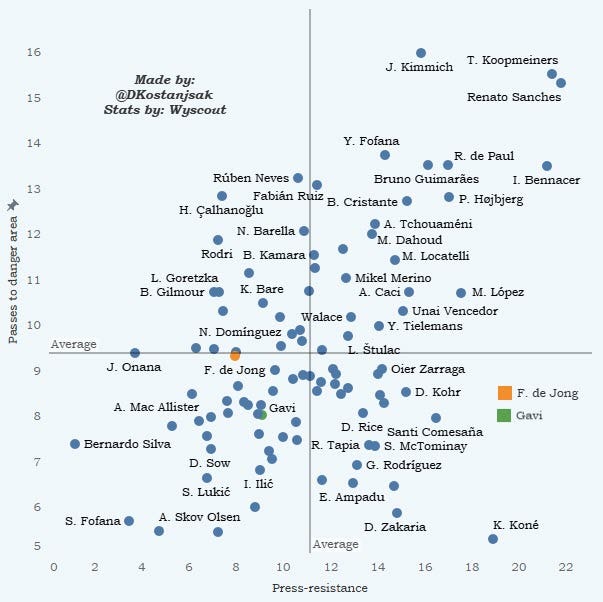
This is also where things get a bit more complicated. Passes to the danger area are simple - they represent the combination of passes into the final third and passes into the penalty area per 90. Barcelona pivots don’t need to be creators as such. Their jobs are focused on the deeper areas of the pitch. However, considering the Catalans want to dominate possession, their pivots will often find themselves just at the entrance into the final third and they will be tasked with finding gaps and exploiting channels towards their more advanced players. With that in mind, we still need players who are effective in the ‘danger areas’.
Now the press-resistance metric. Press-resistance as such doesn’t exist in the Wyscout database. Sadly, we cannot just log in and select it as one of the categories and the platform will automatically list the best press-resistant players in the world. For that reason, I had to get creative with it. To get a metric that mimics press-resistance, I’ve created the following formula: (dribbles won per 90 + offensive duels won per 90 + forward passes per 90) - backwards passes. Initially, I had experimented with ‘negative passing’ as a metric instead of just backwards passing, which includes lateral passes as well. However, that seriously hampered players who play for possession-heavy teams and as a result tally a huge number of lateral passes per game.
In the end, most of them had negative results so I had to remove the lateral passes and use only the backwards ones. That being said, Kimmich is once again among the top players. Next to him, we see the likes of Rodrigo de Paul, Sanches, Teun Koopmeiners and Ismaël Bennacer. These players are among the elite here; players who are press-resistant and great passers as well. But as was the case before, we’re only taking the upper-right quadrant with some players who are only marginally below it.
Next, duelling and defensive traits.

At this point, I’d like to remind you these are not just players who are good at duelling and defensive actions. These are players who are elite in ball progression, passing to the danger areas, are heavily involved for their sides and are also press-resistant. But now we’ll see which ones are also physical and great defenders. Duels won includes both offensive and defensive duels while successful defensive actions include defensive duels, interception and sliding tackles.
The players we’re interested in are in red or pink and also the ones that are still in the upper-right quadrant. Physique is just a combination of weight and height. Sadly, that’s the best Wyscout data can offer us at the moment. Bruno Guimarães, Mikel Merino, Aurélien Tchouaméni and Kalvin Phillips are players who dominate this metric. Bennacer is once again here but his slender stature might limit his chances to feature in the final shortlist.
For the final score, I’ve added up the players’ results, included their market value to filter for availability and consulted our physique metric. Below are the results.

Kimmich has dominated almost every category imaginable. However, he is still not as athletic and is firmly out of Barcelona’s reach. A similar thing goes for Bennacer, who’d fit nicely but his lack of athleticism means he won’t make the cut. Once again, the players we are looking for are a perfect mix of technical quality and clear physical traits.
The Shortlist
One note before we continue, however. All the graphs were made by my good friend Marcus Bring (@MarcusBr22) so make sure to follow him. Also, the players are not listed in any particular order.
With that in mind, let’s meet our contestants.
Bruno Guimarães, Olympique Lyon
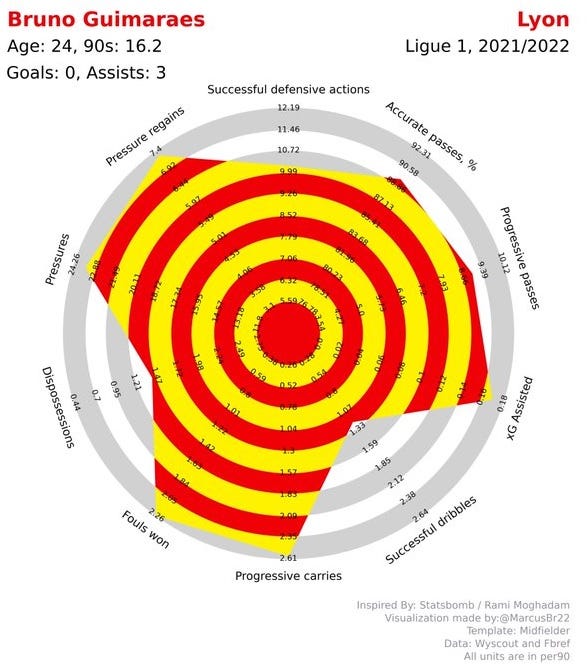
Guimarães is a 24-year-old midfielder playing for Olympique Lyon. His inclusion on this list might feel a bit strange. He’s not a pure holding midfielder as such. We could describe him as a hybrid between a no.6 and a no.8. Moreover, at Lyon, he’s been mostly deployed in a double pivot. All of this means he’s not exactly an ideal option to replace Busquets in a single pivot Barcelona system.
However, his mix of ability and physicality is simply off the charts and the radar above speaks for itself. Guimarães is indeed excellent on the ball, a great progressor and an incredible passer, he is active and successful defensively but also very dangerous and creative in attack.
But what made me put him on the list despite the aforementioned caveats is that he has clear qualities of a 6. He’s comfortable staying deeper and just ahead of the defence in possession and focusing on distribution. Similarly, in the final third, he’ll sit just behind the forward line and thread passes into the box. He does, however, like to push forward at times, which is a trait he shares with De Jong. Just like the Dutchman, he’d have to dose his aggression if he were deployed as a Barcelona pivot.
In that regard, perhaps a double-pivot of them two would be the better option. But I still feel there is clear potential here too.
Pierre-Emile Højbjerg, Tottenham Hotspur
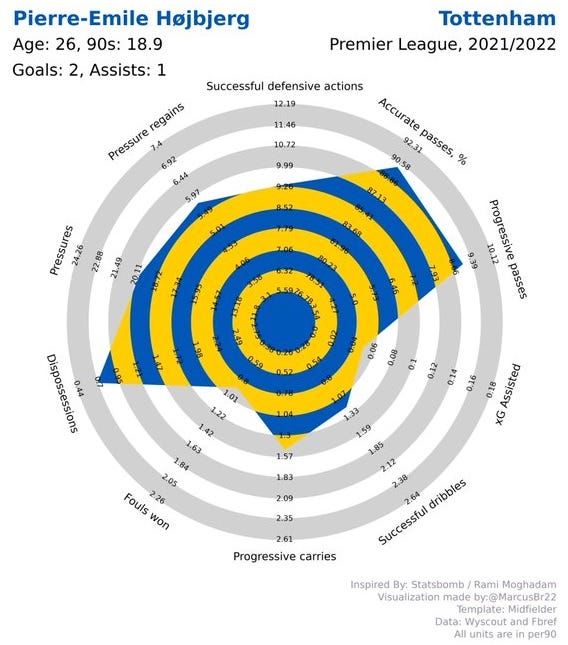
Pierre-Emile Højbjerg is a 26-year-old midfielder currently playing for Tottenham Hotspur. His inclusion may surprise many but the Dane is truly an outstanding player who’s playing in a struggling team that’s now trying to recover under Antonio Conte. He, too, passed all the tests with almost flying colours, exhibiting great ability on the ball, defensive work rate, press-resistance and the ability to dominate duels from that deep position.
But just like Guimarães before him, Højbjerg isn’t exactly being used as a lone pivot for Spurs. Often, we’ll find him in a double-pivot or as a no.8 just ahead of the 6. However, he offers a strong physical presence in the back and can dominate duels with power and speed. Similarly, when in possession in the deeper areas, he can ping balls over the top with accuracy.
While not necessarily always utilised for it, Højbjerg can still dribble and even join the attack when given the freedom to do so. He’d, however, need to exhibit more adventurous passing in settled phases of possession as a Barcelona pivot needs to be able to consistently break lines.
Another limiting aspect may be availability. Højbjerg may not break any records with his fees but he’s a player in his prime and on a long-term contract.
Boubacar Kamara, Marseille
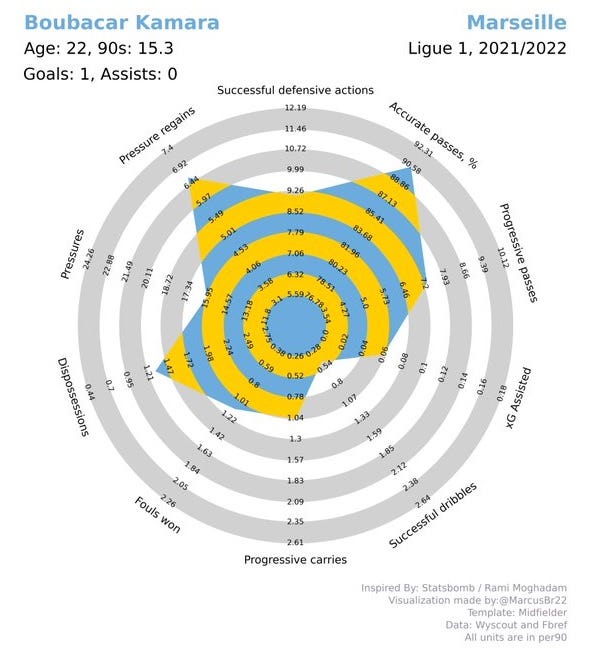
Boubacar Kamara is a 22-year-old midfielder playing at Marseille. He is also among the players who have already been linked with a move to Barcelona. And after consulting the data, it’s easy to see why. This is a player who can cover multiple positions but is also quite adept at playing as a single pivot for his club. Kamara is great on the ball, quite progressive, defensively acute and boats a physical presence. In short, he ticks almost all the boxes on our list.
As a player who likes to start and mostly stay deep, he’s great at distributing long balls into space but can also thread nice passes to break the lines from both those deep but also more advanced positions. Kamara’s long strides mean he can catch up to attackers and cover depth while his defensive traits also procure efficiency in 1v1 duels.
All of that being said, he can be adventurous and carry the ball forward when given a chance. This isn’t inherently a flaw as such but similarly to De Jong, it might be limited at Barcelona. But the fact he’s so versatile and can cover multiple positions while also being among the most realistic targets on the list definitely gives him an edge.
At such a young age, Kamara could still develop but also wouldn’t necessarily instantly displace Busquets in the lineup.
Aurélien Tchouaméni, Monaco
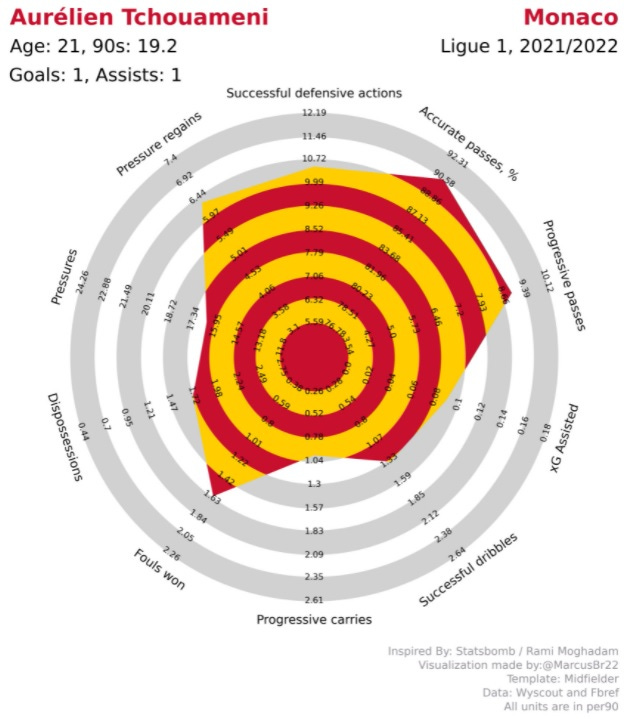
Tchouaméni is a 21-year-old midfielder playing at Monaco. Given the media hype around the youngster, he is a player who needs little introduction and his inclusion on our list is probably not a big surprise to most. And rightfully so. Tchouaméni is a top talent and offers a perfect blend of athleticism and technical quality the modern pivots are required to have. This also makes him a prime target for many top clubs out there, potentially hampering Barcelona’s chances.
Profile-wise, he fits the bill too, albeit with a slight caveat of being predominantly used in a double-pivot at Moncao. However, we’ve seen Tchouaméni in a single pivot role as well but not as often lately. He’s used to be on the ball almost constantly and is extremely accurate and progressive with his passing. That, along with great dribbling ability, turns him into a press-resistance presence that can distribute the ball and break the lines.
Despite a more aggressive nature at times, Tchouaméni is adept at orchestrating from the deep and distributing long and threading passes. His recovery speed and overall physical strength are also impressive and no doubt aid him in 1v1 duels and defensive transitions.
The 21-year-old is definitely among the top picks for the spot, in spite of his tender age. He would be available too but if Barcelona end up having to enter bidding wars for him, it might not be an easy operation to conduct.
Mikel Merino, Real Sociedad
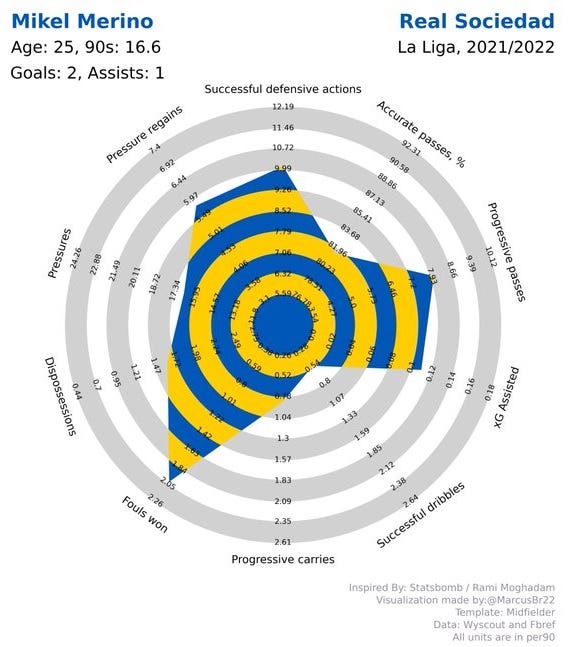
Mikel Merino is a 25-year-old midfielder currently playing at Real Sociedad. On paper, he is not exactly a holding midfielder as he’s usually deployed as a no.8 or in a double-pivot next to Ander Guevara or Martín Zubimendi. However, he has all the qualities a good single pivot needs to have while also being familiar with LaLiga, which is a bonus in Barcelona’s case.
Having watched him play, I will admit his box-to-box nature might hamper his success as a lone no.6 the same way it’s affecting De Jong. Merino is influential higher up the pitch and likes to occupy the left half-space in attack. He will even step out onto the wings and make runs beyond the final third. This makes him more of a no.8, there is no doubt about that.
However, the foundation of a holding midfielder is certainly there. Merino is comfortable distributing from the deep as well as sitting just behind the attack in a settled phase of possession and feed passes into the forwards. On the other hand, he is fast and strong, which makes him a great duelist and an asset in pressures as well as defensive transitions. In our search of players who exhibit a mixture of athleticism and technical quality, Merino is around the very top.
But he may not come cheap and would require some coaching to fully settle into the role. However, I still believe he possesses the right blend of traits that would make for an excellent holding midfielder.
Final remarks
Replacing Busquets like-for-like will be an almost impossible job. There is a reason he’s still enjoying Xavi’s unrelenting trust. Interestingly, when we discarded the physicality and age filters, he was still among the top players on the list. Of course, having watched him play, we can clearly see his limitations that are not necessarily shown in the data.
Let’s not forget about the likes of Frenkie and Nico, both of whom I adore. One thing this analysis has also shown us is that the double-pivot is a very highly rated structure in top European football and that the pivot himself is evolving, hence the presence of no.8s in this piece. Frenkie and Nico could very well lead that revolution at Barcelona and the same would likely happen with most of the players on the list. They would potentially change the ‘Sergio Busquets role’ rather than replace him like-for-like.
And honestly, there wouldn’t be anything wrong with that.
